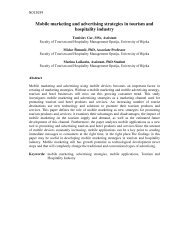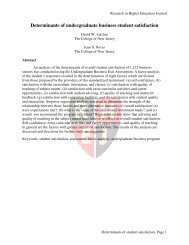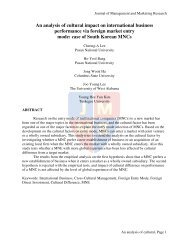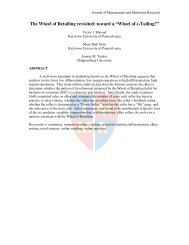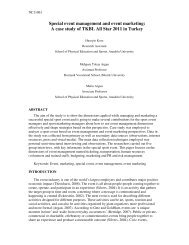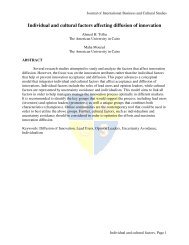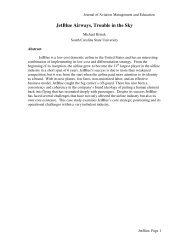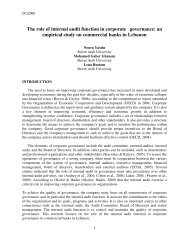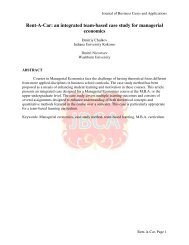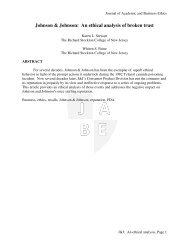Need-Based Segmentation Analysis of University Career Services ...
Need-Based Segmentation Analysis of University Career Services ...
Need-Based Segmentation Analysis of University Career Services ...
Create successful ePaper yourself
Turn your PDF publications into a flip-book with our unique Google optimized e-Paper software.
Research In Higher Education Journal<br />
extant research, this group is likely interested in conducting online job searches at Web sites such<br />
as MonsterTrak.com, a national job listing service for colleges and universities (<strong>University</strong> <strong>of</strong><br />
California Santa Cruz Annual Report, 2004).<br />
Going beyond online delivery preferences, we find descriptive statistics indicating that<br />
best-fit techies are the largest segment, light to moderate users <strong>of</strong> traditional career services (e.g.,<br />
walk-in access to counseling) and are fairly equally distributed across all types <strong>of</strong> majors. Thus,<br />
it is important that UCSCs utilize the Internet (and possibly extranets) to reach this segment,<br />
thereby, freeing staff time for tasks that require human interaction (Rayman, 1999).<br />
Best-fit Techies Strategy: Use E-Marketing<br />
The digerati (those that are savvy regarding digital technologies) that comprise this group<br />
prefer the use <strong>of</strong> electronic networks to deliver career services (Behrens & Altman, 1998;<br />
Davidson, 2001) and information in a variety <strong>of</strong> formats (e.g., podcast and text message). Howe<br />
and Strauss (2003, p. 81), put it this way “millennial generation students expect to use<br />
technology and have the tools necessary to “streamline their educational experience.” Because<br />
research shows that this segment (44% <strong>of</strong> whom are likely liberal arts majors, see Nell, 2003) has<br />
high usage rates for Internet related media (see “Buddy Can You Spare Some Time?” Wall<br />
Street Journal January 26 th , 2004), the following strategies and tactics are suggested:<br />
• drive traffic to the UCSC Web site − even at the expense <strong>of</strong> walk-in traffic<br />
(Davidson 2001) to expose students to targeted communications<br />
• design career-themed “blogs” (online diaries) to appeal to students in this segment<br />
• recruit newly hired students to post videos (and other user-generated content) on<br />
sites such as youtube.com (see White, WSJ 1/2/07, “Firms Take a Cue From<br />
YouTube”)<br />
• enable employers to initially screen student applicants in virtual career fairs<br />
(Steel, WSJ 10/23/07, “Marketers Explore New Virtual Worlds”)<br />
• consider building and maintaining “career communities” (e.g., utilizing the<br />
groups, events and market features in facebook.com)<br />
• allow students to register at UCSC Web sites to have text messages sent to their<br />
cell phones notifying them that employers will be on campus<br />
Despite this abundance <strong>of</strong> opportunities, in a recent study by Nadya et al. (2006), only 34% <strong>of</strong><br />
students were even aware <strong>of</strong> the UCSC Web site despite it being linked to the urban university’s<br />
homepage. Clearly, many UCSCs are unprepared to meet the information needs <strong>of</strong> best-fit<br />
techies.<br />
Unprepareds<br />
The unprepareds are primarily seeking career education and self-development (see Table 3).<br />
Although they are the smallest <strong>of</strong> the four segments (see Table 2), they require innovative and<br />
well thought out appeals to reach them. A careful review <strong>of</strong> the data (see Table 4) reveals that<br />
they have:<br />
• lowest level <strong>of</strong> perceived career orientation and usage <strong>of</strong> career services (4.14 and 1.77)<br />
• a poor success ratio for job interviews (0.10)<br />
• lowest number <strong>of</strong> actual applications (0.64)<br />
• lowest number <strong>of</strong> web site logins (28.86)<br />
<strong>Need</strong>s-<strong>Based</strong> <strong>Segmentation</strong> <strong>Analysis</strong>, Page 13



